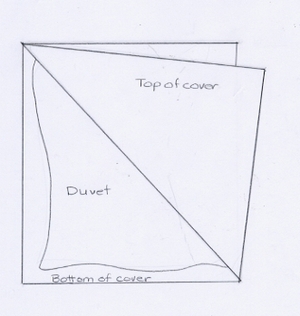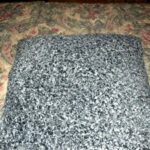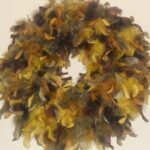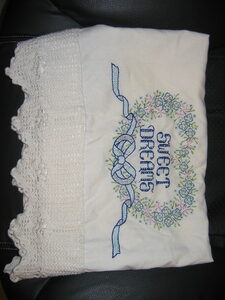(Disclaimer: I’m a miserably poor seamstress. I can’t do clothes, because I put things together upside down and inside out. I’m careless, and impatient, and if I can do this, anyone can, including a smarter-than-average bonobo.)
When you have a feather-filled duvet or comforter, you need to keep it covered to keep it clean. You can buy covers, but most of them are very hard to put on. If, like many of us, you use the duvet without a sheet under it, you will want to change the cover frequently, but changing it isn’t like changing a pillowcase; it’s a real nuisance.
This is one way to make an easy-to-change cover.
What you need:
Two sheets
Velcro or other brand of hook-and-loop fastener.
How to do it:
First, you buy two sheets that are as large as or larger than your duvet. My duvet is queen-sized, but it’s an extra-large queen. However, queen-sized sheets worked fine.
If you’re buying new sheets, you want to pick some that go with your room. You can make your cover the same on both sides, or different; we have a blue checked sheet on one side and a plain yellow one on the other.
Place the right sides of the sheets together, and line them up evenly. Or as evenly as you can! I was surprised to find that sheets aren’t as even as they seem. They may not be exactly square, and the two sheets I used, though the same brand, weren’t really the same size.
When you’ve got the top and one side lined up, smooth the sheets out and pin them together.
Measure your duvet. Add an extra inch in each direction to allow for pouf and seams, and draw a cutting line (a yardstick makes this easier). Then cut along one side and the bottom of your sheets, so you have two pieces of fabric. There will be a hem or selvedge on one side, a hem on the top, and cut edges on the other side and the bottom. I found the cutting was easier if I pinned the sheets together inside the cutting line.
Sew seams along the two cut edges. Now you have two seams that make an “L” shape. The other two sides are neatly finished already, with a hem or selvedge.
A normal duvet cover is sewn along three sides, and you have to struggle to put the duvet in, as if the duvet were an enormous pillow and the cover were a pillowcase.
But what you have here is a cover that folds outward so you only have to get one corner of the duvet in place before you fasten the other two sides. It’s really much, much easier.
Now comes the expensive part. You need ¾ inch Velcro or another brand of hook-and-loop fastener. You need enough of it to go along the whole of both edges – take those measurements of length and width you made, and add them together.
Some stores sell it in from big rolls, with the hooks on one roll and the loops on another; make sure you get both!
Sew the Velcro onto the finished sides, hooks on one side, loops on the other. This is the most boring part. You need the fastener to be tight, so I recommend zig-zagging all four sides of each piece. That means, of course, that you’re doing eight long stretches (at the sides of the tape, maybe six or seven feet) and eight little bits (at the end of the tape, where it’s ¾ inch wide).
When it’s done, you lay it on the bed, open it up so there’s a big triangle flap, flop your duvet on top, and – Tuck, zip, it’s all done.
If you don’t want to use all that Velcro, you can use small dots, but don’t use the really lightweight stuff. I tried that, and it kept coming open in the night. Also, it was tricky to be sure the dots were opposite each other. When you use a long strip, the opening and closing are easy, and the duvet stays firmly inside where it belongs.
Once nice thing is that this doesn’t have to be perfect. Down-filled comforters always look kind of friendly and rumpled anyway, so if you sew your seams a little crookedly, who cares?
We’ve slept cozy all winter, and changed the duvet cover almost as easily as a sheet!







